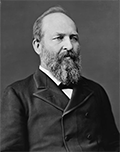James A. Garfield
James A. Garfield was a teacher, lawyer, minister, army veteran, Congressman, and the 20th President of the United States. He was in the White House only a short time: His term and his life were cut short by an assassin's bullet. 
He was born on Nov. 19, 1831, in Cuyahoga County, Ohio. His father, a farmer named Abram, died when the boy was 18 months old. His mother, Eliza, reared her children as well as she could with very little money. James attended a nearby school and then Geauga Academy and the Western Reserve Eclectic Institute (which became Hiram College) in Hiram. He graduated from the Massachusetts institution Williams College in 1856. Garfield had taught classical languages at the Eclectic Institute to help put himself through school. One of his students was Lucretia Randolph, whom he later married, in 1858; they had seven children together. 
He returned to Eclectic and served as its president in 1857–1861. A busy man, he studied law and won admittance to the bar while also studying for and being ordained into the ministry. At the same time, he served in state politics, winning election to the Ohio state senate in 1859. He served one term there and then, when the Civil War began, joined the Union Army. He saw action in the West, at Shiloh and at Chickamauga. He served as chief of staff to Maj. Gen. William S. Rosencrans and reached the rank of major general before he left the Army, in 1863, to run for Congress. He won election to the U.S. House of Representatives, representing Ohio's 19th District. He was still serving in that capacity when he ran for President in 1880. Garfield had returned to his legal roots in 1866, as one of three attorneys who appeared before the U.S. Supreme Court in the landmark case Ex parte Milligan. Garfield and his colleagues argued successfully that their clients, civilians who had been convicted of treason by a military court, should have been tried in a civilian court instead. Garfield was implicated in the 1872 Crédit Mobilier scandal, involving improper use of funds in the construction of the Transcontinental Railroad, but was not charged with criminal activity. The following year, he took the blame from his constituents for the "Salary Grab," a move by Congress to increase its pay by 50 percent; Garfield had opposed the bill but nearly lost re-election because of its passage. Former President Ulysses S. Grant came out of retirement in 1880 and sought the Republican Party nomination, but the party chose Garfield. Running for the Democratic Party was Civil War general Winfield Scott Hancock. One of the main issues of the election campaign was whether to impose higher tariffs on other countries. Republicans said yes, and Democrats said no. Garfield won the election, barely, by less than 2,000 popular votes. The electoral vote tally was a bit of a wider spread, 214–155. All of the Southern states, with the addition of California and Nevada, went for Hancock. The Northeast and the Midwest went for Garfield, whose running mate was Chester A. Arthur. (Garfield had also been elected to the U.S. Senate but did not take up that post.) 
On July 2, 1881, Garfield was at the Baltimore and Potomac Railroad Station in Washington, D.C., on his way to a family vacation in New England, when Charles Guiteau, a lawyer who had been unsuccessful in gaining a governmental job, shot him in the back. The President did not die from the wound but, rather, from infections sustained during treatment. His doctors tried for months to find the bullet; even noted Alexander Graham Bell had a try, using a metal detector that he had invented. Garfield breathed his last on September 19; he was 49. At 200 days, it was the second-shortest presidential term in history, behind only that of William Henry Harrison, who died after 31 days in office. Vice-president Arthur became President when Garfield died. Garfield had made civil service reform and civil rights for African-Americans priorities for his time in office. Arthur signed into law a package addressing the first of those priorities. Garfield appointed several African-Americans to prominent government positions. Among those was longtime abolitionist Frederick Douglass as recorder of deeds in Washington and, as register to the Treasury, Blanche Bruce, the first African-American to be elected to and serve a full term in the U.S. Senate. Garfield and his Secretary of State, James G. Blaine, had sought to enable the U.S. to build a canal in Panama and to give the U.S. more influence in Hawaii. Garfield had also nominated Justice Stanley Matthew to the Supreme Court. |
|
Social Studies for Kids
copyright 2002–2025
David White




